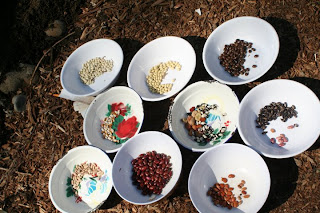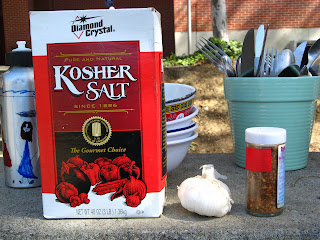
This past Saturday at the farm we planted bush beans. A bush bean can be described as a bean plant whose bushy growth does not need support, like a trellis to climb. We planted nearly ten different varieties, seen above. But first, the back story.
On these particular beds we had planted spinach. I wasn't part of that planting, but I imagine it went something like this. Two inches of compost was spread on native soil. Using digging forks and spades, the 2 inches of compost was mixed with the below 6 inches of native soil, with a little Dr. Earth mixed in for good measure. Any clods of dirt were broken up, and any stones bigger than a golf ball, and sticks bigger than a cigarette were sifted out. The loose, airy soil/compost mix was then formed into two raised, flat beds, with a 18 inch path dividing them. The spinach seeds were then planted and covered with fine, sifted compost.
Unfortunately, the spinach didn't take, and its growth stopped after a couple weeks. This is where the bush beans come in. Beans are nitrogen fixers, which means they capture nitrogen from the atmosphere and deposit it in the soil (actually, bacteria and microbes living in their roots do that in exchange for carbohydrates). Nitrogen is a key nutrient for plant growth, and beans are often used to enrich nutrient poor soil with nitrogen. We thought we'd give them a try. So...
We prepared the beds nearly identical to the spinach beds with a couple key differences. First, from turning a little bit of the soil, we could see it was dark, with plenty of organic material, so adding compost wasn't necessary this time, and in fact may have been detrimental. Again, dirt clods were broken up, stones were removed, and the beds were formed. We made 3 rows about 12-18 inches apart, and planted the seeds at 6 inch intervals, about two finger knuckles deep. This time, we didn't cover the seeds with fine, sifted compost because the beans are hearty enough to break through to the surface.
These beans were planted in the beds nearest the garden entrance, by the hay bales, so check out there progress in the coming weeks!

















